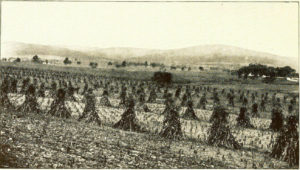by James Rada, Jr.
Indians Capture a Fairfield Family
Editor’s Note: This is the first in a series of columns about Richard Bard’s escape from captivity and the rescue of his wife.
Hannah McBride, a young girl who was at Bard’s Mill, near Fairfield, Pennsylvania, on April 13, 1758, happened to glance out the door of the house. She screamed when she saw men running toward her. She turned to call out a warning to the others in the house, but it was too late.
Nineteen Delaware Indians rushed the house. Richard Bard, the mill owner, grabbed a pistol from its peg on the wall and fired at one of the Indians. The pistol misfired, but the sight of it must have frightened the Indian, and he ran off. Another Indian attacked Bard’s cousin, Thomas Potter, with a knife. The two men struggled over the knife and Potter managed to cut the Indian on the hand.
However, there were just too many Indians. Bard, his wife, and son; Potter; Hannah; Frederick Ferrick, an indentured servant; two field hands; and a young boy were all captured and forced to follow their captors. Potter was killed and scalped, most likely because he had injured one of the Delawares. The Indians also burned the mill down.
About four miles from the mill, the Indians killed Bard’s son without warning. The party moved over South Mountain to the head of Falling Spring. They moved north of Fort Chambers and onto Rocky Spring, and camped for the night near Fort McCord in present-day Franklin County, Pennsylvania. The prisoners had walked forty miles that first day.
As they entered Path Valley on the second day, the Delawares discovered that a group of white men was pursuing them. The Delawares and their prisoners moved to the top of Tuscarora Mountain and threatened to kill the prisoners if the white pursuers reached them.
Bard and Samuel Hunter, one of the field hands, sat down to rest at the top of the mountain “when an Indian without any previous warning sunk a tomahawk into the forehead of Samuel Hunter, who was seated by my father, and by repeated blows put an end to his existence. He was then scalped and the Indians proceeding on their journey encamped that evening some miles on the north of Sideling Hill,” Archibald Bard, one of Bard’s children, wrote years later.
The group hiked on to Blair Gap in Blair County, Pennsylvania, and while crossing Stoney Creek, the wind blew Bard’s hat from the head of the Indian who had taken it for his own. While the Indian went to recover it, Bard crossed the creek. The Indian returned and saw Bard had crossed. He was so angry that he pistol-whipped Bard and nearly disabled him.
“And now reflecting that he could not possibly travel much further, and that if this was the case, he would be immediately put to death, he determined to attempt his escape that night,” Bard wrote after the ordeal.
Another thing pushing his decision was that half of his face had been painted red two days earlier. “This denoted that a council had been held and that an equal number were for putting him to death and for keeping him alive, and that another council was to have taken place to determine the question,” Bard wrote.
After the Indians laid down to rest, one of them dressed in Catherine Bard’s gown to amuse his companions. While the Delawares relaxed, Richard Bard was sent to get water without his captors paying too close attention to him. When Bard got about 100 yards away, the Delawares realized that he was getting away.
They chased after him, but he was gone.
The Indians spent two days looking for him, but Richard Bard had made his getaway.

The Bard Plantation.

